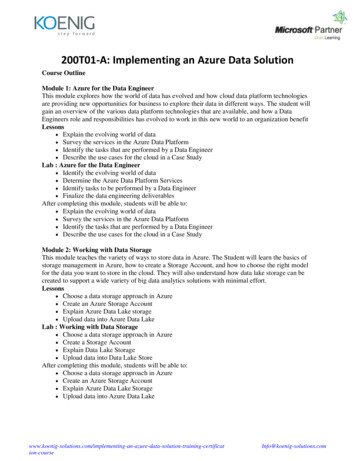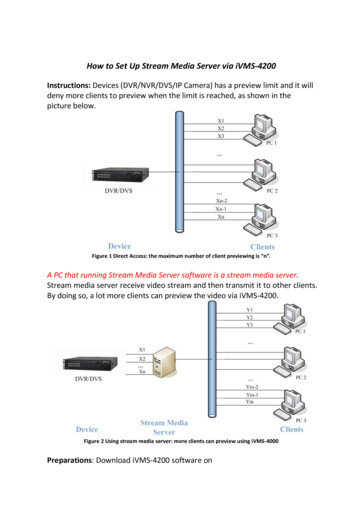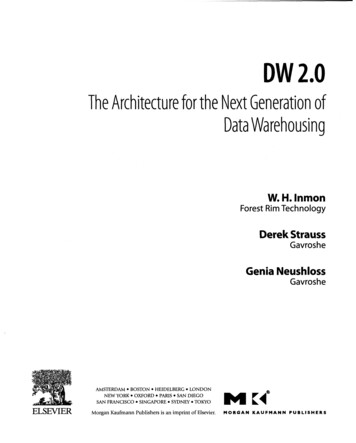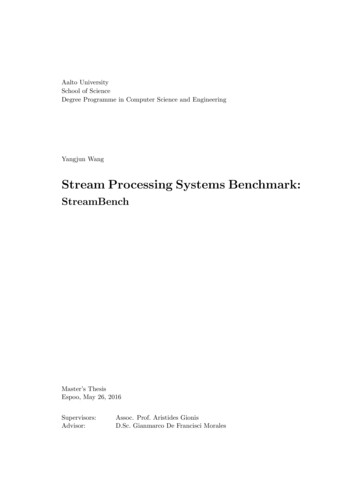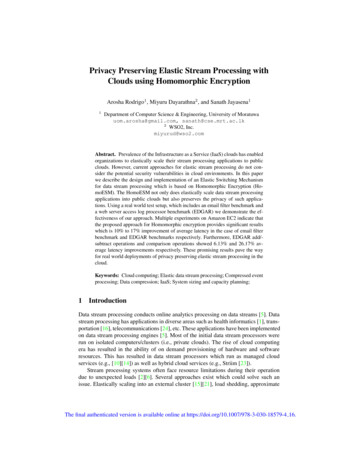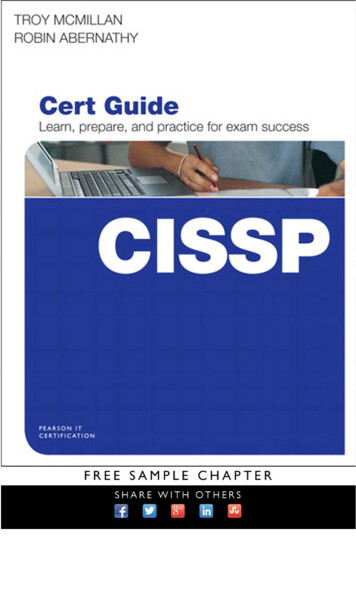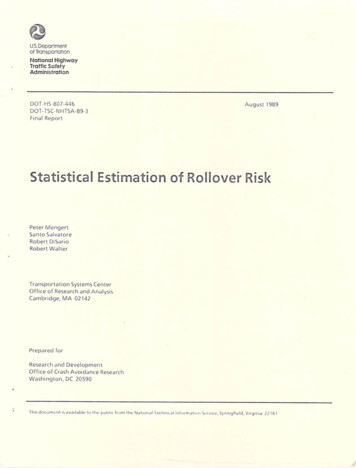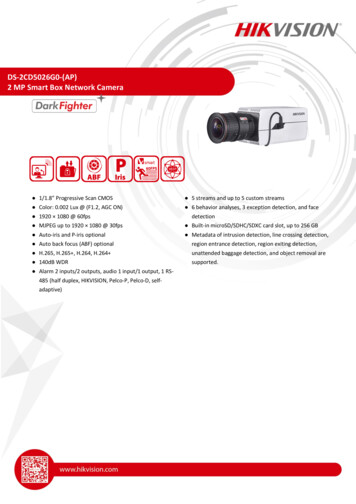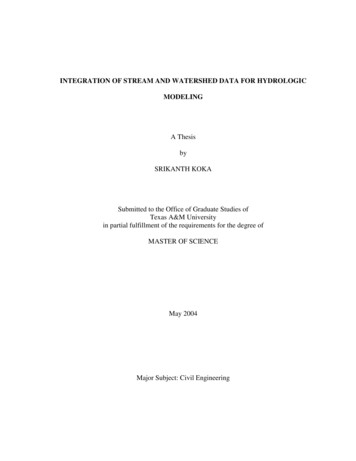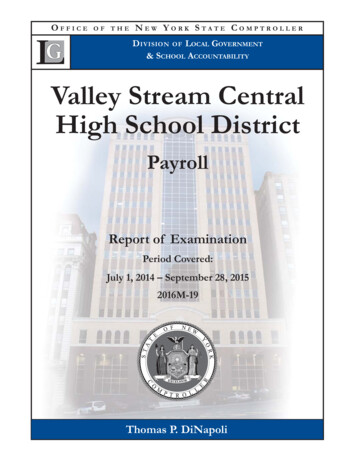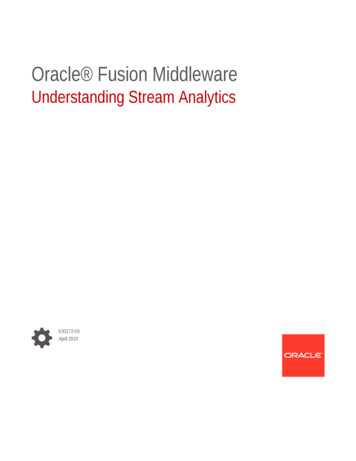
Transcription
Mythbusters:Event Stream Processing v.Complex Event ProcessingDEBS 2007, TorontoJune 20, 2007Tim Bass
Our AgendaAn Illustrative Survey of Steams and CloudsEvent Processing Reference ArchitectureWrap-Up2 2007 SilkRoad Inc. All Rights Reserved.
A Vocabulary of Confusion (Work in Progress)SensorManagementResource ManagementProcessingManagementControlSensor FusionPlanningCorrelationTrackingComplex EventProcessingInformationFusionData MiningData Fusion3Estimation 2007 SilkRoad Inc. All Rights Reserved.Event StreamProcessingAdapted from: Steinberg, A., &Bowman, C., CRC Press, 2001
Clouds from Thermal StreamsRef: www.paragliding.gr/cd-rom/aerology.htm4 2007 SilkRoad Inc. All Rights Reserved.
Dust Clouds and StreamsRef: es/stream.jpg5 2007 SilkRoad Inc. All Rights Reserved.
Gulf Stream6 2007 SilkRoad Inc. All Rights Reserved.
Ocean Currents as Streams7 2007 SilkRoad Inc. All Rights Reserved.
Weather Data as a re/cloud.png8 2007 SilkRoad Inc. All Rights Reserved.
Business Events as CloudsDavid Luckham9 2007 SilkRoad Inc. All Rights Reserved.
David Luckham on Streams and Clouds An event stream is a special case of an event cloud. An event stream is a sequence of events ordered bytime, such as a stock market feed. An event cloud is the result of many event generatingactivities going on at different places in an IT system. A cloud might contain many streams.Luckham, D., What’s the Difference Between ESP and CEP?,http://complexevents.com/?p 103 , 1st August 200610 2007 SilkRoad Inc. All Rights Reserved.
Formally: Streams and CloudsDavid Luckham, CEP-Interest Yahoo! Feb 16, 2007STREAM a linearly orderedsequence of events.CLOUD: a partially ordered setof events.Examples: 1, 2, 3, 4, 5, . i.e., theintegers under order.- also, a stock market feed.Examples: planar points (x,y)under the order,(x,y) (u,v) ifand only if x u and y v. - also,all email messages on theInternet at any instant.CloudsStreams11 2007 SilkRoad Inc. All Rights Reserved.
An Event Stream as a type of Data Stream Formally: A data stream is anordered pair (s,Δ) where: 1. s is a sequence of tuples, 2. Δ is the sequence of timeintervals (i.e. rational or realnumbers) and each Δn 0. Examples: stock quotes click streams network traffic GPS signals sensor network applications.12 2007 SilkRoad Inc. All Rights Reserved.
David Luckham on Streams and ESP Processing a stream of events in their order of arrivalhas advantages. Algorithms for processing the data in the events thatuse very little memory because they don’t have toremember many events. The algorithms can be very fast. They compute on events in the stream as they arrive,pass on the results to the next computation and forgetthose events. Event stream processing is focused more on highspeed querying of data in streams of events andapplying mathematical algorithms to the event data.13 2007 SilkRoad Inc. All Rights Reserved.
David Luckham on Clouds and CEP In clouds, you can’t assume that events arrive in a nice order. You may be looking for sets of events that have a complexrelationship. CEP applies to a richer set of business problems, not onlyevent data processing, but also business process management,for example. CEP is designed for extracting information from clouds ofevents created in enterprise IT and business systems. CEP includes event data analysis, but places emphasis onpatterns of events, and abstracting and simplifying informationin the patterns, to span the broadest possible area of enterprisemanagement decision. CEP takes more memory and more time!14 2007 SilkRoad Inc. All Rights Reserved.
Janak Parekh, Columbia University (USA)Thesis Proposal: Privacy-Preserving Distributed Event Correlation “Event streams are generally confined to anindividual organization [ ] and correlationsystems remain within the organization’snetwork [ ]” pp .1 “Producers publish events into the event“cloud”, and subscribers indicate interest inclasses of events, either via subscriptions tochannels or by declaring interest in certainclasses of context.” pp. 6Ref: .pdf15 2007 SilkRoad Inc. All Rights Reserved.
Zhang Yelei, University of Twente (Netherlands)Masters Thesis: Index Processing for Complex Event Detection “[Cloud ] results from a large amount ofdistributed activities around the world andit’s usually unstructured.” pp .17 “Producers publish events into the event“cloud”, and subscribers indicate interest inclasses of events, either via subscriptions tochannels or by declaring interest in certainclasses of context.” pp. 6Ref: http://wwwhome.cs.utwente.nl/ zhangyy/thesisv2.pdf16 2007 SilkRoad Inc. All Rights Reserved.
Event Processing Technical Society WGhttp://complexevents.com/?p 124 Event stream: a linearly ordered sequence of events. Event cloud: a partially ordered set of events (poset), either boundedor unbounded, where the partial orderings are imposed by the causal,timing and other relationships between the events. 17Notes: Usually, streams are ordered by time, e.g., arrival time. An event streammay be bounded by a certain time interval or other contextual dimension(content, space, source, certainty), or be open ended and unbounded.Notes: Typically an event cloud is created by the events produced by one ormore distributed systems. An event cloud may contain many event types, eventstreams and event channels. The difference between a cloud and a stream is thatthere may not be an event relationship that totally orders the events in a cloud. Astream is a cloud, but the converse is not necessarily true. 2007 SilkRoad Inc. All Rights Reserved.
POSET (A,R) : SET (A) and Relationship (R)18Set ARelationship RAbstractionSet of all stock tradesfor GOOG within a 5minute time windowLinearly ordered bytime.Event streamSet of all stock tradesin NASDAQ for asingle day.Partially orderedSet of all log fileentries in a singlebanking applicationLinearly ordered bytime.Set of all bankingsystemsPartially ordered.A chain of events.Event cloudMany incomparablechains of events.Event streamA chain of events. 2007 SilkRoad Inc. All Rights Reserved.Event cloud
CEP Clouds and ESP StreamsA Stream is a Special Case of a Cloud.19EVENT CLOUDSEVENT STREAMSNetwork ManagementWeb Traffic Session ExtractionWeatherTemp Data from Station ZuluEnterprise Security / SEMAlerts from Firewall or IDSInsider Trading / FraudEOG Financial TransactionsLogistics / Supply ChainTracking RFID InformationGlobal EpidemiologyTylenol OTC SalesHomeland SecuritySan Ysidro Border CrossingsInvestor SentimentMarket Data from NASDAQ Sales 2007 SilkRoad Inc. All Rights Reserved.
Philip Howard on CEP v. ESPBloor Research Analyst Opinion “A typical ESP application is one suchas algorithmic trading “ “CEP is about what we might call überevents or, more specifically, patterns ofevents.” “CEP is a superset of ESP.”Howard, P., ESP and CEP.what's the difference?,Reg Developer, 6 June 200520 2007 SilkRoad Inc. All Rights Reserved.
Our AgendaAn Illustrative Survey of Steams and CloudsEvent Processing Reference ArchitectureWrap-Up21 2007 SilkRoad Inc. All Rights Reserved.
Data Clouds Actionable KnowledgeAnalysis of Situation & PlansImpact AssessmentHIGHSituational AssessmentRelationship of EventsContextual and CausalAnalysisCausal Analysis, BayesianBelief Networks, NNs,Identify EventsLocation, Times and Ratesof Events of InterestMEDCorrelation, State Estimation,ClassificationExistence of PossibleEvent of InterestUse of DistributedSensors for EstimationsData/Event CloudRaw Sensor Data(Passive and Active)LOWAdapted from: Waltz, E. & Llinas, J., Multisensor Data Fusion, 199022 2007 SilkRoad Inc. All Rights Reserved.22
Functional Reference ArchitectureEVENTSOURCESEXTERNALEVENT PREPROCESSINGFunctional Reference Architecture for CEPDISTRIBUTEDLOCALEVENTSERVICES.EVENT.PROFILES. .DATABASES.OTHERDATALEVEL ONELEVEL TWOLEVEL YSISVisualization,BAM, UserInteractionDB MANAGEMENTLEVEL FOURHistoricalDataProfiles &PatternsADAPTIVEBPMAdapted from JDL:Steinberg, A., & Bowman, C., Handbook of Multisensor Data Fusion, CRC Press, 200123 2007 SilkRoad Inc. All Rights Reserved.24
AI, Agents and BlackboardsKSKSKSKSKSKSKSKSKSEVENT CLOUD(DISTRIBUTED DATA SET)KSKSKSKSKSAdapted from: Engelmore, R. S., Morgan, A.J., & and Nii, H. P., Blackboard Systems, 1988 &Luckham, D., The Power of Events, 200224 2007 SilkRoad Inc. All Rights Reserved.22
Event Processing and Data Fusion Multi-level inference in a distributed event-decision architectures User Interface (Dashboards, BAM, Visualization, Portals) Human visualization, monitoring, interaction and situation managementLevel of Level 4 – Process Refinement (Adaptive BPM)Inference Decide on control feedback, for example resource allocation, sensor andstate management, parametric and algorithm adjustmentHighMed Level 3 – Impact Assessment (Predictive Analytics) Impact assessment, i.e. assess intent on the basis of situation development,recognition and prediction Level 2 – Situation Refinement (Situational Detection) Identify situations based on sets of complex events, state estimation, etc. Level 1 – Event Refinement (Event Tracking) Identify events & make initial decisions based on association and correlationLow25 Level 0 – Event Preprocessing Cleansing of event-stream to produce semantically understandable data 2007 SilkRoad Inc. All Rights Reserved.
Processing Patterns for Event ProcessingProcessing PatternsBusiness /ScientificContext26InferenceProcessingTechniques 2007 SilkRoad Inc. All Rights Reserved.
Inference Algorithms for Event Processing A sample of event processing algorithms relevant to CEP: Rule-Based Inference Bayesian Belief Networks (Bayes Nets) Dempster-Shafer’s Method Adaptive Neural Networks Cluster Analysis State-Vector Estimation Key Takeaway: Analytics for CEP exist in the art & science of many disciplines - theseanalytics can be mapped to recurring business patterns. Rules are only one of many methods for CEP.27 2007 SilkRoad Inc. All Rights Reserved.
Map Business Context to Classical MethodsNote: For Illustrative Purposes OnlySensor OptimizationComplex DiagnosticsFraud DetectionIntrusion DetectionNetwork ManagementHurricane ForecastingOpportunistic TradingCompliance MonitoringSupply Chain OptimizationBusiness / Science Context28Classical InferenceBayesian Belief NetworksHidden Markov ModelsDempster-Shafer’s MethodSelf-Organizing Feature MapsState-Vector EstimationRule-Based InferenceAdaptive Neural NetworksInference Processing Techniques 2007 SilkRoad Inc. All Rights Reserved.
Example Inference Patterns for Event Processing Bayesian Techniques: SPAM Filtering Telecommunications Fraud Detection Fraud & Intrusion Detection Financial Risk Management Credit Approval and Credit Limit Automation Medical Diagnosis Military ID, Command and Control Rules Algorithmic Trading Routing and Scheduling Fraud Detection29 2007 SilkRoad Inc. All Rights Reserved.
MythsESP and CEP are One in the SameRules are the Brains of CEP30 2007 SilkRoad Inc. All Rights Reserved.
31 2007 SilkRoad Inc. All Rights Reserved.
Thank You!Tim BassThe Complex Event Processing Blog eventprocessing.wordpress.comwww.silkroad.com
Appendix – Backup Slides Example Stream Processing Challenges Posets and Tosets33 2007 SilkRoad Inc. All Rights Reserved.
Example Stream Processing Challenges Noise from the data sources Resource management of the system resources Evolutionary changes in data trends Approximate query answering Limited memory Limited storage Limited bandwidth Limited processing Out of order data34 2007 SilkRoad Inc. All Rights Reserved.
Partially Ordered Sets of Events POSET A relation R on a set A is called a partial order if R isreflexive, antisymmetric, and transitive. The set Atogether with the partial order R is called a partiallyordered set or poset, and is denoted (A,R). R is a partial order on A if it has: Reflexivity: a a for all a A Antisymmetry: a b and b a implies a b Transitivity: a b and b c implies a cRef: http://mathworld.wolfram.com/35 2007 SilkRoad Inc. All Rights Reserved.
Linearly or Totally Ordered Sets (TOSETS)In totally ordered sets of events, all events are comparable to the others. Linearly or Total Ordered Set of Events If (A, R) is a poset, we say A is totally ordered if for allx, y A either x R y or y R x. In this case R is called atotal order R is a total order on A if it has: Reflexivity: a a for all a A Antisymmetry: a b and b a implies a b Transitivity: a b and b c implies a c Comparability: for any a, b A, either a b or b a. The first three are the axioms of a partial order, whileaddition of the trichotomy law defines a total order.Ref: http://mathworld.wolfram.com/36 2007 SilkRoad Inc. All Rights Reserved.
Relations What does the relation mean? Anything consistent with the properties of an order relation may beconsidered a partial order. Examples of relations include: geometrical containment (e.g., in the work by W. Kainz) membership among building parts (my work about scene space) being earlier in a sequence (e.g., in Kuipers 1979) The first two are specific instances of a general partof relation.37 2007 SilkRoad Inc. All Rights Reserved.
Gallery of PosetsProduced by the package Posets.nb38 2007 SilkRoad Inc. All Rights Reserved.
Posets ook.html39 2007 SilkRoad Inc. All Rights Reserved.
Mythbusters: Event Stream Processing v. Complex Event Processing DEBS 2007, Toronto June 20, 2007 Tim Bass
